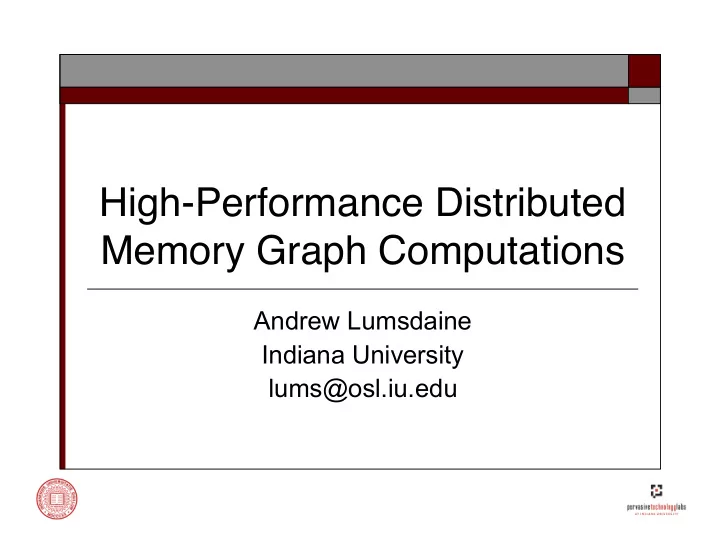

High-Performance Distributed Memory Graph Computations Andrew Lumsdaine Indiana University lums@osl.iu.edu
Introduction Overview of our high-performance, industrial strength, graph library Comprehensive features Impressive results Lessons on software use and reuse
Advancing Scientific Software Why is writing high performance software so hard? Because writing software is hard! High performance software is software All the old lessons apply No silver bullets Not a language Not a library Not a paradigm Things do get better, but slowly
Advancing Scientific Software Progress, far from consisting in change, depends on retentiveness. Those who cannot remember the past are condemned to repeat it.
Advancing Scientific Software Name the two most important pieces of scientific software over last 20 years BLAS MPI Why are these so important? Why did they succeed?
MPI is the Worst Way to Program Except for all the others!
Evolution of a Discipline Science Production Professional Engineering Commercialization Educated professionals Analysis and theory Skilled craftsmen Progress relies on science Craft Established procedure Analysis enables new apps Training in mechanics Market segmented by Concern for cost product variety Virtuosos, talented amateurs Manufacture for sale Extravagant use of materials Design by intuition, brute force Knowledge transmitted slowly, casually Cf. Shaw, Prospects for an engineering Manufacture for use rather than sale discipline of software, 1990.
Evolution of Software Practice Ad-hoc solutions New Problems Folklore Improved Practice Models, Theories Codification
Evolution of Software Language Ad-hoc solutions New Problems Folklore Improved Practice Languages Libraries
What Doesn’t Work Codification Models, Theories Improved Practice Languages
The Parallel Boost Graph Library Goal : To build a generic library of efficient, scalable, distributed-memory parallel graph algorithms. Approach : Apply advanced software paradigm (Generic Programming) to categorize and describe the domain of parallel graph algorithms. Reuse sequential BGL software base. Result : Parallel BGL. Saved years of effort.
Sequential Programming
SPMD Programming
Reuse
Graph Computations Irregular and unbalanced Non-local Data driven High data to computation ratio Intuition from solving PDEs may not apply
Generic Programming A methodology for the construction of reusable, efficient software libraries. Dual focus on abstraction and efficiency . Used in the C++ Standard Template Library Platonic Idealism applied to software Algorithms are naturally abstract, generic (the “higher truth”) Concrete implementations are just reflections (“concrete forms”)
Generic Programming Methodology Study the concrete implementations of an algorithm 1. Lift away unnecessary requirements to produce a more 2. abstract algorithm Catalog these requirements. a) Bundle requirements into concepts . b) Repeat the lifting process until we have obtained a 3. generic algorithm that: Instantiates to efficient concrete implementations. a) Captures the essence of the “higher truth” of that algorithm. b)
The Boost Graph Library (BGL) A graph library developed with the generic programming paradigm Algorithms lift away requirements on: Specific graph structure How properties are associated with vertices and edges Algorithm-specific data structures (queues, etc.)
The Sequential BGL The largest and most mature BGL ~7 years of research and development Many users, contributors outside of the OSL Steadily evolving Written in C++ Generic Highly customizable Efficient (both storage and execution)
BGL: Algorithms Searches (breadth-first, Max-flow (Edmonds-Karp, push-relabel) depth-first, A*) Sparse matrix ordering (Cuthill- Single-source shortest McKee, King, Sloan, minimum paths (Dijkstra, Bellman- degree) Ford, DAG) Layout (Kamada-Kawai, All-pairs shortest paths Fruchterman-Reingold, Gursoy- Atun) (Johnson, Floyd-Warshall) Betweenness centrality Minimum spanning tree PageRank (Kruskal, Prim) Isomorphism Components (connected, Vertex coloring strongly connected, Transitive closure biconnected) Dominator tree Maximum cardinality matching
BGL: Graph Data Structures Graphs: adjacency_list : highly configurable with user-specified containers for vertices and edges adjacency_matrix compressed_sparse_row Adaptors: subgraphs, filtered graphs, reverse graphs LEDA and Stanford GraphBase Or, use your own…
BGL Architecture
Parallelizing the BGL Starting with the sequential BGL… Three ways to build new algorithms or data structures Lift away restrictions that make the component 1. sequential (unifying parallel and sequential) Wrap the sequential component in a 2. distribution-aware manner. Implement any entirely new, parallel 3. component.
Lifting Breadth-First Search Generic interface from the Boost Graph Library template < class IncidenceGraph, class Queue, class BFSVisitor, class ColorMap> void breadth_first_search( const IncidenceGraph & g, vertex_descriptor s, Queue & Q, BFSVisitor vis, ColorMap color); Effect parallelism by using appropriate types: Distributed graph Distributed queue Distributed property map Our sequential implementation is also parallel!
BGL Architecture
Parallel BGL Architecture
Algorithms in the Parallel BGL Connected Breadth-first search* components ‡ Eager Dijkstra’s Strongly connected single-source shortest components † paths* Biconnected Crauser et al. single- components source shortest paths* PageRank* Depth-first search Graph coloring Minimum spanning Fruchterman-Reingold tree (Boruvka*, Dehne layout* & Götz ‡ ) Max-flow † * Algorithms that have been lifted from a sequential implementation † Algorithms built on top of parallel BFS ‡ Algorithms built on top of their sequential counterparts
Abstraction and Performance Myth : Abstraction is the enemy of performance. The BGL sparse-matrix ordering routines perform on par with hand-tuned Fortran codes. Other generic C++ libraries have had similar successes (MTL, Blitz++, POOMA) Reality : Poor use of abstraction can result in poor performance. Use abstractions the compiler can eliminate.
Lifting and Specialization
DIMACS SSSP Results
DIMACS SSSP Results
The BGL Family The Original (sequential) BGL BGL-Python The Parallel BGL Parallel BGL-Python
For More Information… (Sequential) Boost Graph Library http://www.boost.org/libs/graph/doc Parallel Boost Graph Library http://www.osl.iu.edu/research/pbgl Python Bindings for (Parallel) BGL http://www.osl.iu.edu/~dgregor/bgl-python Contacts: Andrew Lumsdaine <lums@osl.iu.edu> Douglas Gregor <dgregor@osl.iu.edu>
Summary Effective software practices evolve from effective software practices Explicitly study this in context of HPC Parallel BGL Generic parallel graph algorithms for distributed-memory parallel computers Reusable for different applications, graph structures, communication layers, etc Efficient, scalable
Questions?
Recommend
More recommend